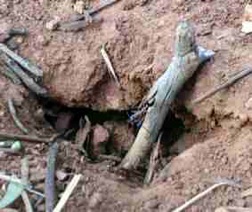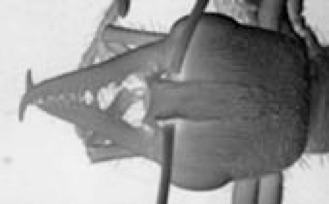Jumper ant allergy

IMPORTANT The information provided is of a general nature and should not be used as a substitute for professional advice. If you think you may suffer from an allergic or other disease that requires attention, you should discuss it with your family doctor. The content of the information articles and all illustrations on this website remains the intellectual property of Dr Raymond Mullins and cannot be reproduced without written permission.
Introduction
Allergic reactions to stinging ants are an important cause of anaphylaxis in Australia and the southern United States. Allergic reactions to the Jack Jumper ant (also known as the Jumper Ant, Hopper Ant) are a uniquely Australian problem, although other species such as the Green Ant of Queensland, and introduced South American Fire Ant cause occasional allergic reactions.
What is a Jack Jumper Ant?
Most Australian native stinging ants are from the genus Myrmecia. This group is broadly subdivided into “Jumper ants” and “Bull Dog ants”. Bull Dog ants are large, around 15-25 mm long, whereas Jumper ants are generally 10 to 15mm long and often display jerky, jumping movements. Jumper Ants are also known as “Hopper Ants” or “Skipper Ants” in South Australia. The Jumper Ant most frequently associated with allergic reactions is commonly known as the “Jack Jumper Ant”, “Jack Jumper” or “Jumping Jack”. Jack Jumpers have a black body and orange/brown jaws/pincers and limbs.
Jumper ants sting rather than bite
Like bees and wasps, they do not bite. Rather, they grasp the victim in their jaws, then bend and sting them. The sting is in the tail! They are aggressive, typically walk with a hopping motion, and can sometimes “jump” from surrounding vegetation.
The Jack jumper ant has a widespread distribution in Australia
These ants are found in Tasmania, Victoria, The ACT, the Snowy Mountains of New South Wales and coastal New South Wales, the Adelaide Hills in South Australia, and with some pockets reported in the Blue Mountains, some parts of Western Australia and unconfirmed sightings in Queensland. It is likely that there are other (as yet undescribed) habitats as well, and that observations relate to interactions between ant colonies and human habitats.
Nests are often difficult to find
Ants live in underground nests. Although established nests can form massive mounds, they are often difficult to find, and may be present under rock, with the entrance surrounded by a pile of fine gravel. Typically, a couple of sentry ants are present at the entrance. The ants are aggressive, and often hunt alone. They will stray away from the nest, and at times find their way into people's houses and kitchens. It is very difficult to avoid being stung by jumper ant in endemic areas, when nests are located close to human inhabitants.
Allergic reactions may occur to ant stings
There are different types of allergic reactions to stinging insects. The stings of jumper ants, like those of bees and wasps, are very painful. Local swelling is very common. Large local swellings can also occur, lasting a few days at a time. The most serious reactions are known as generalised allergic reactions, of which the most severe is called anaphylaxis.
Anaphylaxis is the most serious type of allergic reaction
Anaphylaxis occurs after exposure to an allergen (such as food, insect sting or medicine), to which a person is already extremely sensitive. It results in potentially life-threatening symptoms, including:
oDifficulty/noisy breathing
oSwelling of tongue
oSwelling/tightness in throat
oDifficulty talking and/or hoarse voice
oWheeze or persistent cough
oChest tightness
oAbdominal pain, nausea, and vomiting
oConfusion, loss of consciousness and/or collapse
oPale and floppy (in young children)
In some cases, anaphylaxis is preceded by less dangerous allergic symptoms, such as:
oSwelling of face, lips and eyes
oCongestion and watering of the nose and eyes
oHives or welts on the skin
oHeadaches, anxiety, flushing,
Anaphylaxis to Jumper Ant stings is not rare
In areas where jumper ants are common, population surveys have shown that between 2 and 3 per cent of people have had generalised allergic reactions, and in around half of these people the reactions can be life-threatening. Deaths from jumper ant stings and anaphylaxis have occurred in Australia, with several recorded cases in recent years. Since allergy as a cause of death can be difficult to detect at post mortem, it is conceivable that deaths due to sting allergy are under-reported.
Jumper Ant allergy does not disappear quickly
Follow-up studies have shown that around 70 per cent of people with jumper ant allergy, will have another allergic reaction if re-stung. This sensitivity to repeat stings appears to persist for many years.
Diagnosing Jumper Ant allergy
There is currently no skin allergy test available outside of ant allergy research programmes in Tasmania. A blood allergy test is available from IMVS Laboratories, South Australia. Tests can be arranged with your doctor and local pathology laboratory. There is a small out-of-pocket cost for this test, which detects around three-quarters of cases of Jumper ant allergy.
Management options
Patients with allergic reactions to jumper ants, as with other allergies, need to avoid the trigger (where possible), carry emergency medication (adrenaline/EpiPen) and know what to do if accidental exposure occurs. Wearing a MedicAlert bracelet may provide additional information to attending doctors or ambulance officers.
•Avoiding Jumper Ants
•Other measures
•Emergency action plan
•Prospects for immunotherapy
Avoiding Jumper ants
Jumper ants are difficult to avoid in endemic areas, as they often stray long distances from the nests. Destroying nearby nests has been proposed to reduce the risk of accidental stings, and but may not prevent stings from nests located further away. But get professional advice on how to remove the nests/kills the ants. Wearing heavy clothing such as boots and gloves when in the bush or when gardening seems sensible, and spraying boots and lower clothes with insecticide may help but the ants can still sting through heavy clothing. Whether moving from endemic areas to another area may help is uncertain.
Other measures
•Those allergic to Jumper Ants should carry a means of summoning assistance if stung, such as a mobile telephone.
•They should not travel alone in remote areas, and consider carrying an emergency satellite beacon and additional emergency medication if traveling in areas without easy access to medical assistance.
•Although antihistamines might possibly help relieve very milder symptoms, there is no evidence currently that they will prevent a serious allergic reaction. Adrenaline/EpiPen is the ONLY medication proven to help with serious allergic reactions.
•There is some evidence that certain medications used in the management of blood pressure and heart problems may worsen anaphylaxis or interfere with the action of adrenaline administered in an emergency. This poorly defined risk, however, needs to be balanced against the benefits that these medications provide. Patients taking any form of blood pressure or heart medication should discuss the relative risk and benefits of their use with their allergy specialist and perhaps a heart specialist/cardiologist.
•All patients with stinging insect anaphylaxis should be referred to an immunology/allergy specialist for assessment and advice.
Emergency Action Plan
Patients with life-threatening (anaphylactic) reactions should:
-
•Seek urgent medical assistance if stung.
-
•Carry (and know how to use) an automatic adrenaline injector (EpiPen). Adrenaline acts as a natural "antidote" to some of the chemicals released during severe allergic reactions. This is the only medicine able to counteract the dangerous effects of anaphylaxis. Medications taken orally, such as antihistamines or steroids, have no effect on the immediate and dangerous effects of anaphylaxis. Adrenaline should be considered as First Aid for the treatment of anaphylaxis.
It is important to note that in some cases, more than one dose of EpiPen may be necessary. Even if the Epipen has been highly effective at relieving symptoms, continue to seek emergency medical care without delay. Subjects who have had a serious allergic reaction should be held at medical care under continuous observation for at least six hours after resolution of all abnormal symptoms and signs (with the exception of the reaction at the sting).
Using the EpiPen
Make sure you know how to use the EpiPen and refresh your memory from time to time, so that you know what to do in an emergency. You can get instructions for using EpiPen and EpiPen Jr from:
-
•Our web page HERE
-
•Your GP or allergy specialist who prescribed the EpiPen. EpiPens Trainers (without a needle) can be used for practice.
-
•Your Anaphylaxis Action Plan. These contain clear pictures and instructions and should be kept with the EpiPen. Instructions for use of EpiPen are available from the Australasian Society for Clinical Immunology and Allergy (ASCIA) website http://www.allergy.org.au.
Prospects for immunotherapy
Commercial venom extracts are available in Australia for the diagnosis and treatment of patients allergic to honey bees and Paper wasps and European wasps. At this time, there is no commercial venom extract available for skin testing to confirm jumper ant allergy or to use for immunotherapy (desensitisation, allergy injections), to switch off the allergy. Studies performed by Australian doctors in Tasmania demonstrated that Jumper Ant venom extracts were very effective at switching off Jumper Ant allergy, and preventing allergic reactions when patients were re-stung. Members of ASCIA are attempting to make this treatment more widely available by advocating for support for further research. While there is a vaccine to switch off serious allergic reactions to Jumper ant allergy which has been shown to be affective, it is not commercially available, but research is ongoing. Some centres in Adelaide, Melbourne and Tasmania are able to offer jumper ant immunotherapy but there is not country-wide availability.
Check for updates
If you or a family member are allergic to Jumper Ants, you should check the ASCIA web site from time to time at http://www.allergy.org.au. ASCIA members are actively involved in researching this uniquely Australian problem, and important updates on treatment options and research programmes will be posted there when available.
Last reviewed 5 June 2020

